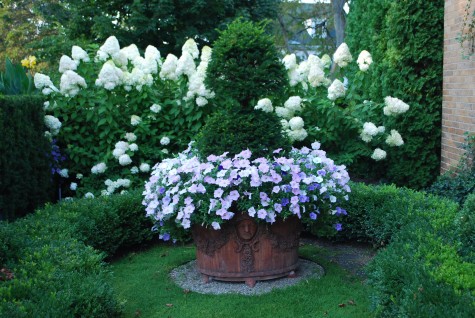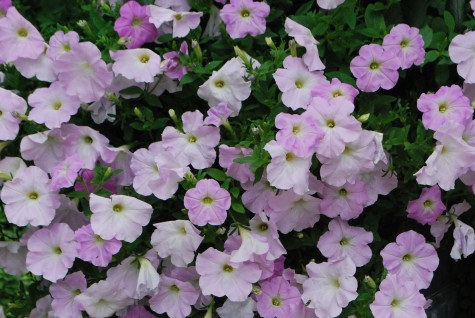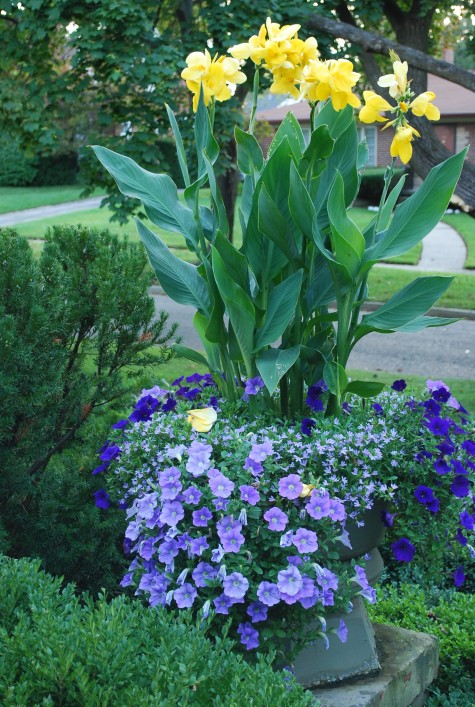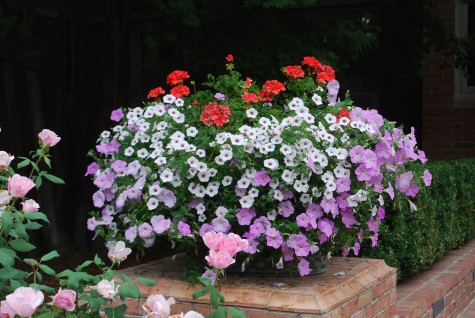 I was asked recently if I had any tips for growing great petunias-this from Ann who writes the Plumsiena blog. If you have not read it, give it a try. I enjoy her point of view. But back to the petunias; my first tip-if you love petunias, keep growing them until you get the culture down pat. I really like the fragrance. I like the shape and simplicity of the flower. I like all of the colors. White, cream, yellow, orange, red, all the shades of pink, cerise, lavender, purple-and don’t forget the bicolor petunias. They come single and double. They come mini, standard, and trailing. What do I like? I put my effort behind this.
I was asked recently if I had any tips for growing great petunias-this from Ann who writes the Plumsiena blog. If you have not read it, give it a try. I enjoy her point of view. But back to the petunias; my first tip-if you love petunias, keep growing them until you get the culture down pat. I really like the fragrance. I like the shape and simplicity of the flower. I like all of the colors. White, cream, yellow, orange, red, all the shades of pink, cerise, lavender, purple-and don’t forget the bicolor petunias. They come single and double. They come mini, standard, and trailing. What do I like? I put my effort behind this.
 The Surfinia Blue Sky petunia is one of my favorites. It is a lavender unlike any other lavender-very blue. Blue flowers are in very short supply in a Michigan garden. Cornflowers, and bellamosa delphiniums about wraps up the list. I am having a great run with this petunia this year. I keep them as dry as possible. I lift up the foliage with my forearm, and water the soil only. I keep my fingers crossed that summer will be short of rain-as it usually is. What usually is-I cannot depend on this.
The Surfinia Blue Sky petunia is one of my favorites. It is a lavender unlike any other lavender-very blue. Blue flowers are in very short supply in a Michigan garden. Cornflowers, and bellamosa delphiniums about wraps up the list. I am having a great run with this petunia this year. I keep them as dry as possible. I lift up the foliage with my forearm, and water the soil only. I keep my fingers crossed that summer will be short of rain-as it usually is. What usually is-I cannot depend on this.
 No kidding, I lift this skirt of petunias up so my water hits the soil, and not the plants. I never put water to the foliage. This plant likes dry-I try to oblige. Rain and high humidity-your petunias will pout. I have had them rot and die overnight in wet weather. I trim the stragglers right along. Hard pruning a petunia means many weeks of recovery. I try to trim a little at a time. Every trailing stem gets a little haircut, frequently.
No kidding, I lift this skirt of petunias up so my water hits the soil, and not the plants. I never put water to the foliage. This plant likes dry-I try to oblige. Rain and high humidity-your petunias will pout. I have had them rot and die overnight in wet weather. I trim the stragglers right along. Hard pruning a petunia means many weeks of recovery. I try to trim a little at a time. Every trailing stem gets a little haircut, frequently.
 It helps to choose the right cultivars. Misty lilac wave petunias are my favorite. The color of this petunia reminds me of the species, while rewarding my efforts with vigorous growth and easy care. Double petunias are leggy-plant them with a frothy friend, like euyphoriba Diamond Frost. Some petunias need a buddy to shine.
It helps to choose the right cultivars. Misty lilac wave petunias are my favorite. The color of this petunia reminds me of the species, while rewarding my efforts with vigorous growth and easy care. Double petunias are leggy-plant them with a frothy friend, like euyphoriba Diamond Frost. Some petunias need a buddy to shine.

Misty Lilac wave petunias-when they are happy, I am happy. Petunias may be the most common of annual plants, but they have an uncommon beauty. When they are good, they are very very good-and when they are bad, they are horrid.
No one knows what weather a summer season will bring. The National Weather Service predicted a wet summer for my zone. Did I lay off the petunias? No; I was willing to take my chances. Any garden planting is about taking chances. Sometimes a season cooperates. Sometimes a season rewards my efforts such that I feel blessed. Some seasons challenge all of my good intentions, and leave me with a bad taste in my mouth.
 For the moment, my petunias are happy. This planter hosting yellow cannas is underplanted with Surfinia blue sky and Royal Velvet petunias. They mix via an alternate planting of scaveola. I am happy about what I see happening here. How did this happen Ann? I have no secrets. Just a big dose of hope, and persistence.
For the moment, my petunias are happy. This planter hosting yellow cannas is underplanted with Surfinia blue sky and Royal Velvet petunias. They mix via an alternate planting of scaveola. I am happy about what I see happening here. How did this happen Ann? I have no secrets. Just a big dose of hope, and persistence.
 I almost always mix my container plantings. I like to hedge my bets. No matter how well I garden, I am always behind that 8 ball we call nature. Plant what you love, tend your garden to the best of your ability, and hope even more for the best.
I almost always mix my container plantings. I like to hedge my bets. No matter how well I garden, I am always behind that 8 ball we call nature. Plant what you love, tend your garden to the best of your ability, and hope even more for the best. 
My petunias-they look great. Am I responsible for that? Not really. I do the best I can. Madame Nature either helps me, or dashes my efforts. Ann, some years my petunias are terrible. Other years, like this year, they prosper. I am not in charge of anything in the garden. The best thing I have going for me is my hope, and my persistence. I give all of the plants in my garden my best effort. I learn new things all the time, and add that to the body of my experience. When things do not work out in spite of my efforts-I do not like it, but I accept it.









